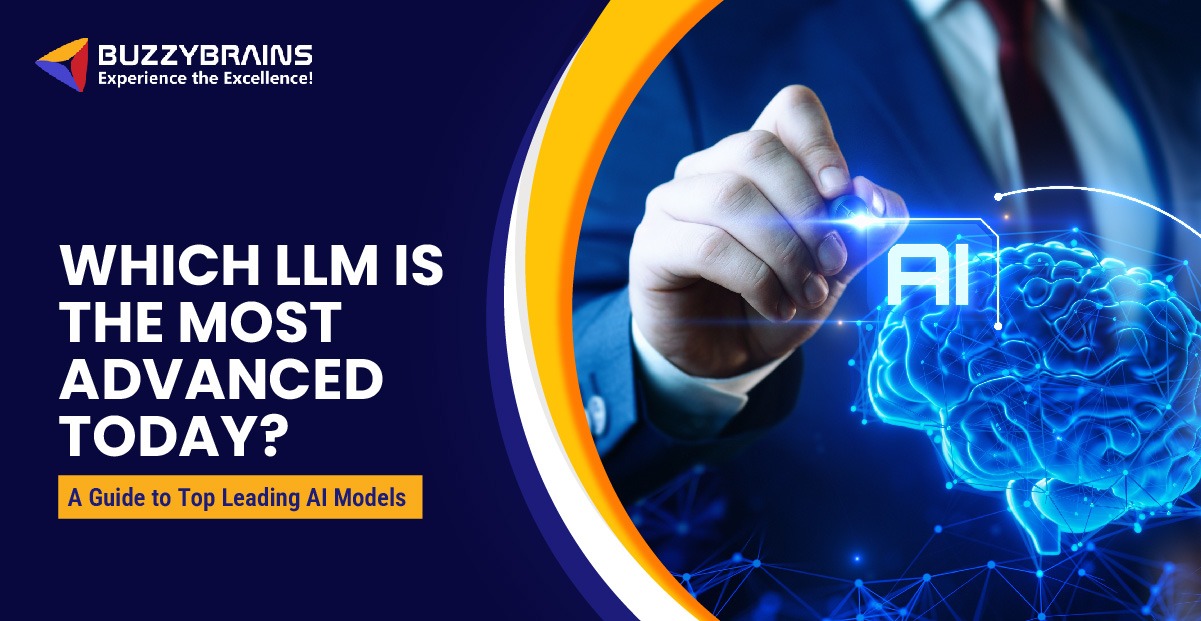Which LLM is the Most Advanced Today? A Guide to Top Leading AI Models

Artificial Intelligence (AI) is changing fast. One of its most exciting parts is the Large Language Model, or LLM. These AI tools can understand and generate human-like language.
In the last few years, LLMs have become smarter and more helpful. But with so many models out there, which one is the most advanced today? Let’s explore.
- What is a Large Language Model (LLM)?
- Types of LLMs
- How Do LLMs Work?
- Most Advanced LLMs Today: Top 10 LLMs in 2025
- Performance Comparison of Top LLMs
- Specialized vs General-Purpose LLMs: Which is Better?
- What Makes an LLM "The Most Advanced"?
- Which LLM is the Most Advanced Today?
- Future Trends in LLMs in 2025
- FAQs About Most Advanced LLMs
- Conclusion
- Explore the Future of AI Development – Connect with BuzzyBrains
What is a Large Language Model (LLM)?
A Large Language Model (LLM) is a type of artificial intelligence. It is trained to understand and produce human language. These models use vast amounts of data and compute power.
LLMs can write essays, answer questions, translate languages, and even write code. They are used in chatbots, apps, business tools, and more.
Types of LLMs
There are different types of LLMs based on their use and design. Each type serves a unique purpose.
- General-purpose LLMs – Can do a wide range of tasks like ChatGPT or Claude.
- Domain-specific LLMs – Trained for a particular industry (e.g., legal, medical, coding).
- Open-source LLMs – Free to use and modify, like LLaMA and Mistral.
- Proprietary LLMs – Owned and managed by companies like OpenAI or Google.
- Multimodal LLMs – Can process both text and other formats like images or audio.
- Instruction-tuned LLMs – Fine-tuned to follow human instructions better.
How Do LLMs Work?
LLMs are based on deep learning models. Most use transformer architecture, introduced by Google in 2017.
Here’s how they work in simple terms:
- Training on Data – They read a large amount of text from books, websites, and more.
- Learning Patterns – They learn how words and sentences connect.
- Generating Output – When you ask something, the model predicts the most likely response.
- Fine-Tuning – Some models are trained further to be safer and more accurate.
- Reinforcement Learning – Some use feedback from humans to improve responses.
Related Blog: Verticalization of Large Language Models
Most Advanced LLMs Today: Top 10 LLMs in 2025
New LLMs keep coming out every few months. Here are the top 10 that stand out in 2025:
1. GPT-4 Turbo (OpenAI)
GPT-4 Turbo is the flagship model powering ChatGPT in 2025. It is known for its speed and efficiency.
Key Features:
- Handles long context windows (up to 128k tokens)
- Fast and optimized for real-time tasks
- High accuracy across tasks
- Multimodal capabilities
Limitations:
- Still prone to hallucination in rare cases
- No full transparency on training data
- Access limited to premium users in some platforms
Use in Real-World Applications:
- ChatGPT by OpenAI
- Microsoft Copilot in Word and Excel
- Enterprise AI assistants
2. Claude 3 Opus (Anthropic)
Claude 3 models are built with safety and alignment in mind. Opus is the most capable version.
Key Features:
- Focus on ethical and safe responses
- Long context handling
- High scores on reasoning benchmarks
Limitations:
- More cautious, may skip risky questions
- Less customizable for developers
Use in Real-World Applications:
- Integrated in Notion AI
- Used in knowledge management tools
- Business process automation
3. Gemini 1.5 Pro (Google DeepMind)
Gemini is Google’s answer to OpenAI. Gemini 1.5 Pro combines text and image understanding.
Key Features:
- Multimodal processing
- Strong integration with Google Workspace
- Fast and precise coding support
Limitations:
- Some users report lower creativity compared to GPT
- Limited access for non-Google ecosystems
Use in Real-World Applications:
- Bard chatbot
- Google Docs and Sheets integration
- Educational apps
4. Mistral 7B & Mixtral 8x7B
Mistral offers open-weight models with exceptional performance. Mixtral uses a mixture-of-experts architecture.
Key Features:
- Lightweight and efficient
- Open-source and developer-friendly
- High performance in reasoning tasks
Limitations:
- Smaller context window
- Not as safe or aligned as proprietary models
Use in Real-World Applications:
- Used in chatbots and assistants
- Deployed in startups and open AI tools
- Educational platforms
5. LLaMA 3 (Meta AI)
Meta’s LLaMA 3 is the latest open-source model. It’s designed for high performance and transparency.
Key Features:
- Fully open-source
- Great for research and customization
- Multilingual support
Limitations:
- Needs tuning for production use
- May require more compute for deployment
Use in Real-World Applications:
- Custom enterprise solutions
- AI research labs
- Academic institutions
6. PaLM 2 / PaLM-Coder (Google)
Google’s PaLM family focuses on code generation and language tasks.
Key Features:
- Trained on high-quality datasets
- Optimized for software development
- Powerful reasoning ability
Limitations:
- Limited fine-tuning options for third parties
- Less adaptable than some competitors
Use in Real-World Applications:
- Android Studio tools
- Google Search enhancements
- Code suggestion engines
7. Command R+ (Cohere)
Command R+ is optimized for retrieval-augmented generation (RAG) use cases.
Key Features:
- Excellent search and summarization ability
- Highly efficient for enterprise search
- Open-weight option available
Limitations:
- Less creative in free-form writing
- Smaller community
Use in Real-World Applications:
- Knowledge base summarizers
- Internal enterprise search tools
- Customer service bots
8. xAI’s Grok (by Elon Musk)
Grok is integrated with X (formerly Twitter) and focused on real-time knowledge.
Key Features:
- Access to live X data
- Humorous and edgy tone
- Works within social media interface
Limitations:
- Not suitable for formal or professional tasks
- Limited multi-use capabilities
Use in Real-World Applications:
- X app (Twitter)
- Social listening tools
- Real-time news summarizers
9. Amazon Titan
Titan is Amazon’s LLM designed for AWS cloud services.
Key Features:
- Tight integration with AWS
- Customizable for enterprise clients
- Private and secure deployments
Limitations:
- Not as popular or widely reviewed
- AWS-centric usage
Use in Real-World Applications:
- Customer service automation
- E-commerce assistants
- Cloud-native AI tools
10. Yi 34B (by 01.AI)
Yi is a strong open-weight model with top-tier benchmarks.
Key Features:
- High scores on MMLU and ARC
- Good for reasoning tasks
- Developer-friendly
Limitations:
- Requires careful prompt engineering
- Still gaining popularity
Use in Real-World Applications:
- Research and academic AI projects
- Independent developer tools
- AI chat interfaces
Performance Comparison of Top LLMs
Here’s how the top models stack up in 2025:
| Sr. No. | LLM Name | Parameters | Context Length | Multimodal | Open Source | Notable Benchmark (MMLU) |
| 1 | GPT-4 Turbo | Unknown | 128K tokens | Yes | No | Very High |
| 2 | Claude 3 Opus | Unknown | 200K tokens | Yes | No | Very High |
| 3 | Gemini 1.5 Pro | Unknown | 1M tokens (chunked) | Yes | No | High |
| 4 | Mistral/Mixtral | 7B–12.9B | 32K tokens | No | Yes | High |
| 5 | LLaMA 3 | 8B–70B | 128K tokens | No | Yes | High |
| 6 | PaLM 2 | Unknown | Moderate | No | No | High |
| 7 | Command R+ | Unknown | 128K tokens | No | Yes | High (for RAG tasks) |
| 8 | Grok | Unknown | Unknown | No | No | Medium |
| 9 | Amazon Titan | Unknown | Moderate | No | No | Medium |
| 10 | Yi 34B | 34B | 32K tokens | No | Yes | High |
Specialized vs General-Purpose LLMs: Which is Better?
Some models are good at many things. Others are designed for a single domain.
Technologies in Specialized LLMs:
- Fine-tuned datasets for specific industries
- Domain-specific vocabularies
- Reinforced learning for context
- Better precision in narrow tasks
General-purpose LLMs:
- Broader use cases
- Flexible but less precise
- Ideal for chatbots and assistants
What Makes an LLM “The Most Advanced”?
Many factors define how advanced an LLM is:
- Model size and architecture
- Quality of training data
- Ability to follow instructions
- Multimodal capabilities
- Context window length
- Safety and alignment
- Efficiency and speed
- Open vs. closed ecosystem
Which LLM is the Most Advanced Today?
In 2025, GPT-4 Turbo and Claude 3 Opus are neck and neck. Both offer excellent performance, long context windows, and safety.
Claude 3 is best for thoughtful, aligned responses.
GPT-4 Turbo is best for speed, versatility, and broad usage.
However, if you’re a developer, open-source options like LLaMA 3 and Mixtral also offer great flexibility.
Future Trends in LLMs in 2025
Here are some key trends shaping the future:
- Rise of agentic AI systems (AI that can plan and act)
- Multimodal LLMs becoming standard
- Better alignment and safety features
- Real-time data and internet-connected models
- Smaller, faster models optimized for edge devices
- Custom LLMs for specific industries
Related Blog: Top 10 Latest AI Trends in 2025
FAQs About Most Advanced LLMs
Q1. What is open source LLMs?
Open-source LLMs are models whose code and weights are publicly available. They can be modified, improved, and used freely.
Q2. Which AI model is best for multilingual tasks in 2025?
Claude 3 and GPT-4 Turbo both perform very well across multiple languages.
Q3. Which LLM does ChatGPT use?
As of 2025, ChatGPT uses GPT-4 Turbo.
Q4. What is the difference between general-purpose and domain-specific LLMs?
General-purpose LLMs can perform many tasks. Domain-specific models are fine-tuned for one area, like legal or medical.
Q5. Are open-source LLMs as good as proprietary models?
Some open-source LLMs like LLaMA 3 and Mixtral match proprietary models in performance, especially when fine-tuned.
Conclusion
The race to build the most advanced LLM is ongoing. Every model has its strengths. GPT-4 Turbo leads in usability and speed. Claude 3 Opus shines in reasoning and alignment.
Your choice should depend on what you need: general performance, safety, or customization.
Explore the Future of AI Development – Connect with BuzzyBrains
Want to integrate the latest AI into your business? At BuzzyBrains, we help you choose and deploy the best LLMs. Whether you’re building an app, chatbot, or automation tool — we bring your vision to life using cutting-edge AI solutions.
Partner with BuzzyBrains and embrace the power of LLMs. Let’s build the future together.

